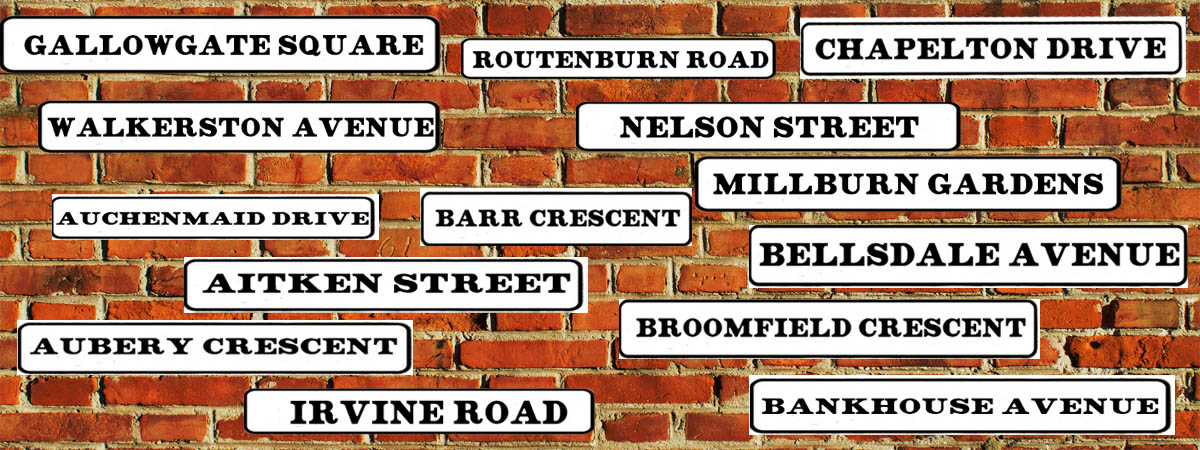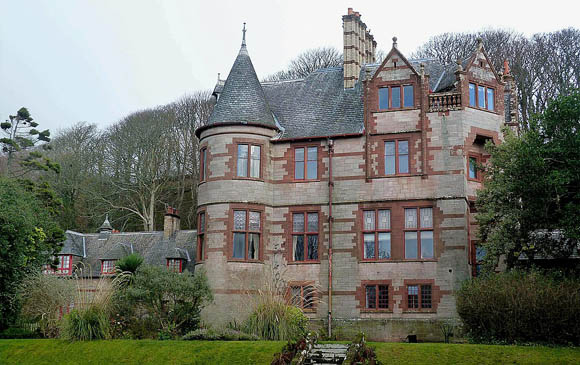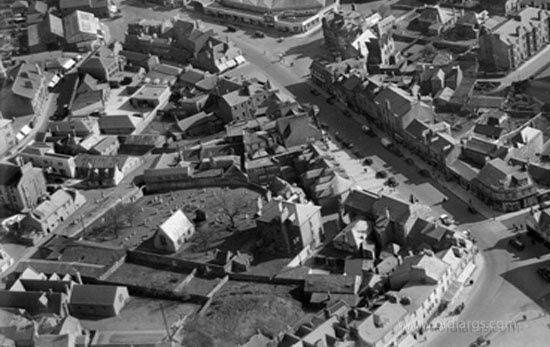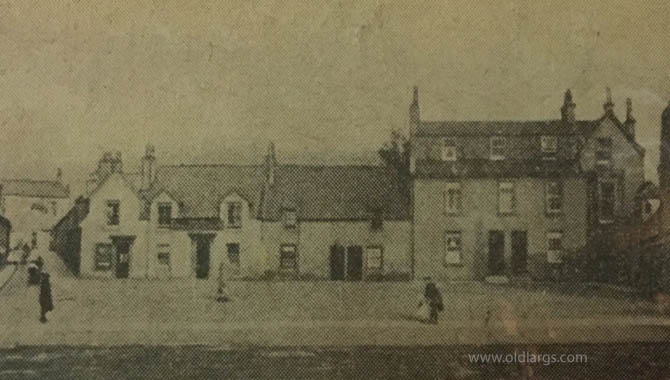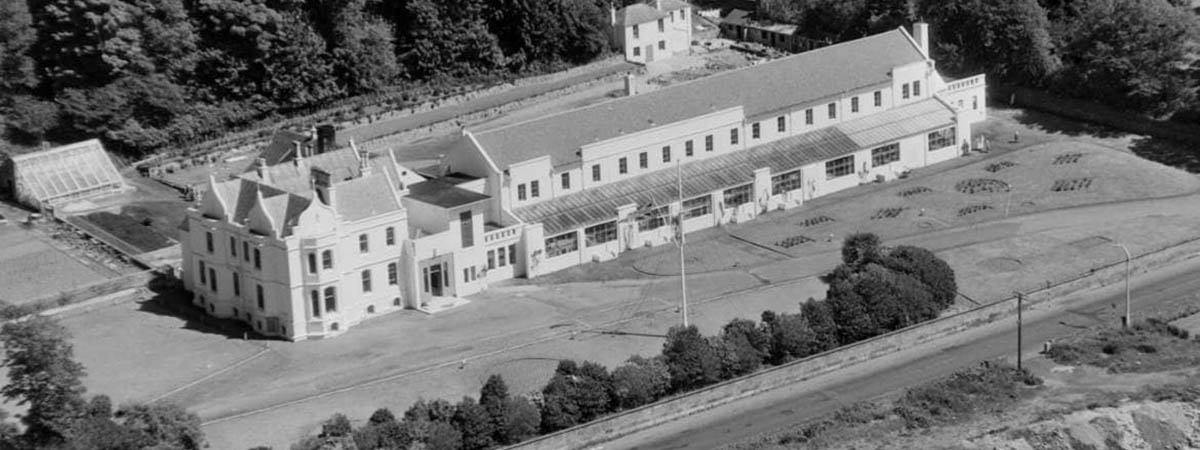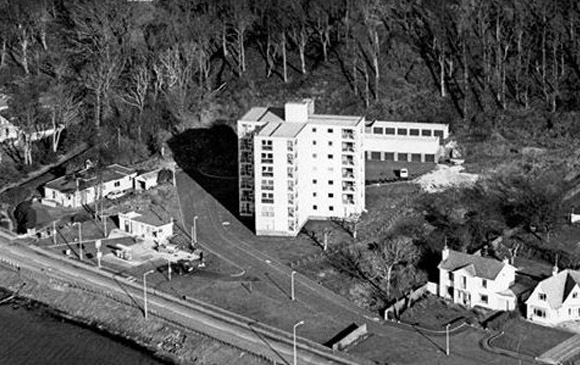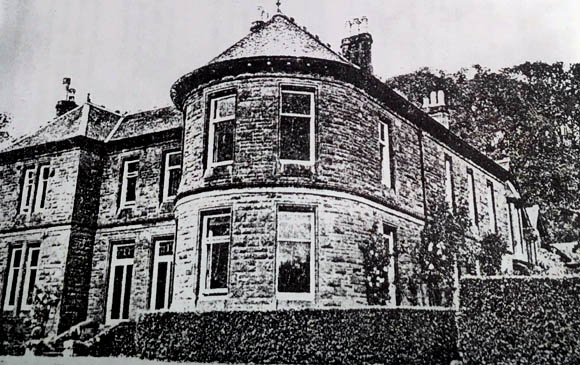Danefield
Part of the land of Danefield house built in 1885 Miss Jessie Graham Crum. It was built in Scottish Baronial style
Miss Crum died in 1912. In 1914 Danefield was sold to Charles Cockburn a manufacturing chemist from Glasgow
After his death his daughter Dorothy sold the grounds to Mickle Mactaggart. In the 70s the house was divided into flats. She occupied the two middle ones until her death in 1979.
Douglas Place
Douglas Place and Douglas Street was known as "babbies' Road and is possibly named after a row of terraced houses known as Douglas Terrance which stood near the foot of the street.
Eastern Avenue
When these houses were built in the 1950s they were the most Easterly building in the town.
Elmbank
The House and lodge built in 1845. Converted to flats in 1960s.
Fernside
The block of flats between 67 and 68 Brisbane Street. Was previously land owned by the Buchannan family who were in the next property. This land was part of their garden.
Flatt
Named after Flatt Farm.
Fort Street
Fort Street used to be called Forth Street. In one of the single story houses was the base for the local customs and excise units. As well as office space it also housed the officers cutlasses and pistols and other weapons.
Frasers Street
Used to be Frasers close. Probably takes its names from the family who had a blacksmith shop located at the entrance of the street. The Frasers may have acquired this business from a Theophilus Rankin and in that time the street has been known as Theophilus close. To confuse things even more the street was also known as Gas Close because the old Gas worked were located there.
Gateside Street
Was known as Weaver's Row in the past
Glen Avenue
Taken after Brisbane Glen.
Glenacre Crescent
Taken from Glenarce Farm which was once located as the end of Glenacre drive.
Glenburn Crescent
Taken from Glen burn.
Gallowgate Square
Taken from Gallow Hill which is located next to the square directly behind the Red Sand Stone building where Subway is today.
Gallow Hill is a large artifical mount measuring 75ft by 27th and 15ft high. This ancient feature has been largely forgotten as it is now overgrown and is not easily assesible today.
There has been much speculation over the years as to its purpose with many convinced that this was the burial place of the Norsemen
killed in the Battle of Largs (in 1263). As it is located near the old Largs grave yard and church it corroborates the Norwegian account of their dead having been interred at or near a church. Other theories over the years was that it was used for executions which ties in with the name Gallow Hill. Its now understood that the site is a Norman Motte dating from the late 12th to early 13th centuray. In medieval times a Motte would also be used by lord or chiefs to administer justice It was probably built by Roland De Calchou. He married Eva Morville in 1195 who had strong family links to the Largs and surrounding areas. The De Calchou name later became the Kelsos.
Human bones were found when the owner of the ground dug into it when building an outhouse. It was partly excavated in 1873 by Dr J S Phene. He found burnt clay, oak charcoal, bright green flakes, supposed to be of copper or bronze, probably 'remnants of armour', and some substances said to be bones. Human teeth were also found.
In this photo of Largs you can make out the circular shape of Gallow Hill at the bottom middle section of the photo.
Gallowgate Square.
George Street
Named after King George V in 1928.
Gogo
Largs has many Streets and roads named after the Gogo Burn. No one is really sure where the name Gogo came from. One suggestion is related to the word Gogo being a very common Welsh place name where a connection exists with a cave or cavern. In our case there is a cavern about 15 feet above the Gogo falls. As there are few other caves in the area this may have given the Gogo water its name. Another suggestion is that the Gogo and Greeto probably originally had endings in -ach giving gogach which would mean the place of nodding or cooings (as of pigeons). Take your pick.
Haco Street
Named after King Haakon Haakonson who was the Norwegain king at the battle of Largs in 1263.
For some reason the Town Council shortened the name to Haco.
Hamilton Court and Drive
Named after Janet Hamilton eldest daughter of Charles Cunningham Scott of Hawkhill
Born 28th December, 1794. Died 27th October, 1875. Charles Cunningham Scott was the great grandson of John Scott who founded ‘Scotts’ shipbuilding at Greenock in 1711. In later generations of Scott’s, the name of his estate changed from Hawkhill to Halkshill.
Harper Crescent
Named after Town provost David Harper.
Holehouse Road
Named after Holehouse Farm
Halkshill
Was known as Hawkhill and Hawkhurst. The original owner of Halkshill estate was John Erskine in 1612.
Haylie
The meaning of Haylie or Hailie (the old spelling) is a burying place. The name Hailley derives from the Saxon word "had il" a grave. The Haylie land is stated to have been in the possession of the Wilson family since 1483 and was sometimes known referred to a "Wislon Haylee" Haylee house was built in 1849 on the site of older houses. In the latter part of the 1800s the house and estate was owned by Dr John Stevenson and later by Charles Cathcart who gifted the house to Largs Council in 1920. The council leased the house and it was run as a hotel for years. It opened as a home for the elderly in the summer of 1955.
Hollywood and Underbank
On this spot was located Underbank House which was a summer residence of Mr Holmes-Kerr until it was sold to a Mr Crawford who lived in the original villa until 1935. In 1936 a consortium of Glasgow businessmen bought the house and a large extension was built in 1938 converting it into the Hollywood Hotel. It opened in 1938 and was a very modern addition to the town with its indoor swimming pool. Local people were allowed to use the pool. The main house was retained and incorporated into the building. When the war came it was requisitioned and the swimming pool was floored over and used as a conference room. It was demolished in 1985 and two sets of flats were built. One called Underbank and the other Hollywood. The image below shows the original Underbank villa
to the far left and the newer extension to the right.
Holmwood Court and Holmwood Flats
This is the old site of Holmwood Lodge built in 1880s for Henry John McCall. By 1947 it was a holiday house for staff of Collins Publishers. The house was demolished in 1965 and flats built. The original plan was for 3 sets of flats however only one set of flats were built. The 5 modern houses behind the Flats we built in the early 1990s which created Holmwood Court.
In this photo of Largs you can make out the circular shape of Gallow Hill at the bottom middle section of the photo.
Holmwood House, built in 1880s.
Moorburn
Named after Moorburn water a stream that starts near the Cauld Rocks and flows past the Inverclyde sports centre and down Glenacre Drive past St Mary’s Church and into the sea. The burn was also called the Muirburn.
Hutton Park Crescent
From Hutton Park House which was built for Thomas Hutton Ingles.
Inverclyde View
These house back onto the Inverclyde sports centre and its grounds.
Irvine Road
The A78 to Irvine used to be called Fairlie Road
John Clark Street
Named after John Clark of Paisley who was a wealthy industrialist whose Anchor Thread Mills, Paisley, was one of the most successful cotton thread manufacturers in the world. From rather humble beginnings, Clark rose to become the director of a huge firm with a factory outlet in America, a public benefactor and a prolific art collector. He was provost of Largs between 1883 - 1889. He was a member of the U.P Church in Waterside Street. When this building became too small he built the Clark Memorial Church at a cost of £30,000 in 1889.
Kelburn Court
Named after Kelburn Castle
Main Street
In the early part of the 1700s Main Street was called High Street.
Mackerston Place
Mackerston Place
Nina Maria MacDougall who married Sir Thomas Brisbane was the daughter of Henry Hay MacDougall, Baronet of Mackerstoun in Roxburghshire. On their marriage Sir Thomas took the additional surname of MacDougall. A villa was built called Mackerston which later became the Mackerston Hotel and the grounds of this villa later became the Mackerston putting green.
Millburn Gardens
Named after the mill stream that ran down from the Gogo burn to the Gogo Mill.
Nelson Street
In 1807 John Paton sold to Dr Archibald Boyd the site at the South West of a street which became
Nelson Street.
